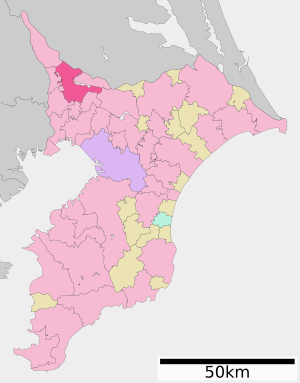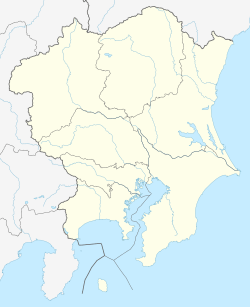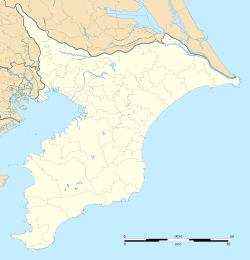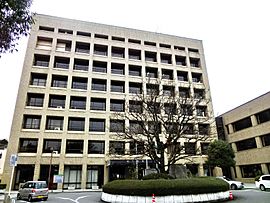Kashiwa facts for kids
Quick facts for kids
Kashiwa
柏市
|
|||||||||
|---|---|---|---|---|---|---|---|---|---|

|
|||||||||
|
|||||||||

Location of Kashiwa in Chiba Prefecture
|
|||||||||
| Country | Japan | ||||||||
| Region | Kantō | ||||||||
| Prefecture | Chiba | ||||||||
| Area | |||||||||
| • Total | 114.74 km2 (44.30 sq mi) | ||||||||
| Population
(May 1, 2024)
|
|||||||||
| • Total | 435,578 | ||||||||
| • Density | 3,796.22/km2 (9,832.2/sq mi) | ||||||||
| Time zone | UTC+9 (Japan Standard Time) | ||||||||
| City symbols | |||||||||
| • tree | Daimyo oak, Castanopsis | ||||||||
| • Flower | Phlox subulata; Erythronium japonicum; sunflower | ||||||||
| • Bird | Azure-winged magpie | ||||||||
| Phone number | 04-7167-1111 | ||||||||
| Address | 5-10-1 Kashiwa, Kashiwa-shi, Chiba-ken 270-8505 | ||||||||
Kashiwa (柏市 (Kashiwa-shi)) is a vibrant city located in Chiba Prefecture, Japan. As of May 1, 2024, about 435,578 people live here in nearly 200,000 homes. The city covers an area of about 114.72 square kilometers.
The name Kashiwa comes from a single Japanese character, 柏. This character refers to the Quercus dentata tree, also known as the Japanese emperor oak or daimyo oak.
Contents
Exploring Kashiwa City
Kashiwa is found on the Shimōsa Plateau, which is a flat, raised area in the far northwestern part of Chiba Prefecture. It's about 30 kilometers from Chiba City, the capital of the prefecture. Kashiwa is also only 25 to 35 kilometers from central Tokyo, making it a convenient place to live. The Tone River forms its northern border, separating it from Ibaraki Prefecture. The city itself is mostly flat, with its height above sea level ranging from 5 to 32 meters.
Nearby Towns and Cities
Kashiwa is surrounded by several other cities and towns. These include:
- In Chiba Prefecture:
- In Ibaraki Prefecture:
- Toride
- Moriya
Kashiwa's Climate
Kashiwa has a climate with warm summers and cool winters. There is usually little to no snowfall. The average temperature for the year is about 14.7°C. September is the wettest month, with an average rainfall of 1358 mm per year. The hottest month is August, with temperatures around 26.5°C, while January is the coldest, averaging about 3.9°C.
Kashiwa's Population Growth
The number of people living in Kashiwa has grown a lot over the last 70 years. This shows that many people have chosen to make Kashiwa their home.
| Historical population | ||
|---|---|---|
| Year | Pop. | ±% |
| 1950 | 49,159 | — |
| 1960 | 75,594 | +53.8% |
| 1970 | 169,115 | +123.7% |
| 1980 | 272,904 | +61.4% |
| 1990 | 347,002 | +27.2% |
| 2000 | 373,778 | +7.7% |
| 2010 | 404,012 | +8.1% |
| 2020 | 426,468 | +5.6% |
Kashiwa's History
Kashiwa has a long and interesting history, going back to ancient times.
Early Days of Kashiwa
The area where Kashiwa is now located has been settled for a very long time. It was once part of an old Japanese province called Shimōsa Province. In 1478, a battle called the Battle of Sakainehara happened here during the Sengoku period (a time of civil wars in Japan).
During the Edo period (1603 – 1868), the land was directly controlled by the Tokugawa shogunate, which was the military government of Japan. The shogunate set up horse farms in the area to raise war horses for their army. They also worked hard to drain marshy areas of Lake Tega to create more land. Kashiwa became an important post station (a resting place for travelers) on the Mito Kaidō road, which connected the capital city of Edo (now Tokyo) with Mito.
Modern Kashiwa Takes Shape
After the Meiji Restoration in 1868, when Japan modernized, Kashiwa Village was officially created on October 1, 1889. In 1896, a railway line connected Kashiwa to Tokyo, which helped the area grow into a busy commercial center.
In the 1930s, Kashiwa became a military town with several military bases, including Kashiwa Air Field and Kashiwa Military Hospital. After World War II, the air field was no longer used, but the hospital is still open today as Kashiwa Public Hospital.
On September 1, 1954, Kashiwa merged with some nearby towns and villages to form a new city called Tokatsu. However, some people disagreed with this merger, and parts of Tokatsu later separated. The remaining part of Tokatsu was renamed Kashiwa on November 15, 1954.
In 1955, a big fire destroyed the old Kashiwa City Hall and much of the city center. In the 1960s, Kashiwa was rebuilt with special government help. This included building Japan's first pedestrian decks at Kashiwa Station in 1973, which made it safer and easier for people to walk around. During this time, many new housing areas were built, causing the city's population to grow rapidly.
On April 1, 2008, Kashiwa was named a core city. This means it gained more local control over its own affairs. By August 2010, the city's population had grown to over 400,000 people!
Kashiwa's Economy
Kashiwa is an important business hub in its region. Many people who live in Kashiwa also travel to nearby Chiba City or Tokyo for work, making it a "bedroom community." About 42.3% of working people in Kashiwa commute to Tokyo.
The city has a mix of different industries. Food processing is a big part of its economy, with companies like Nikka Whisky Distilling, Asahi Soft Drinks, and Ito Ham having factories here. There is also some farming, with turnips, onions, and spinach being grown.
Learning in Kashiwa
Kashiwa is home to several universities and many schools.
Universities in Kashiwa
- Chiba University, Kashiwa Campus
- Kashiwa Campus, University of Tokyo
- Reitaku University
- Nishōgakusha University
- Kaichi International University
Schools for Kids
The city government runs 42 public elementary schools and 20 public middle schools. There are also three private schools that combine middle and high school. The Chiba Prefectural Board of Education operates one combined middle/high school and eight public high schools. Additionally, there are two private high schools and one special education school for students with disabilities.
Getting Around Kashiwa
Kashiwa has good transportation links, especially by train and highway.
Railway Lines
![]() JR East – Jōban Line
JR East – Jōban Line
- Minami-Kashiwa - Kashiwa - Kita-Kashiwa
![]() Tōbu Railway - Tobu Urban Park Line
Tōbu Railway - Tobu Urban Park Line
- Toyoshiki - Kashiwa - Shin-Kashiwa - Masuo - Sakasai - Takayanagi
![]() Metropolitan Intercity Railway Company - Tsukuba Express
Metropolitan Intercity Railway Company - Tsukuba Express
- Kashiwanoha-campus - Kashiwa-Tanaka
Major Highways
 Jōban Expressway
Jōban Expressway National Route 6
National Route 6 National Route 16
National Route 16 National Route 294
National Route 294
Sports Teams in Kashiwa
Kashiwa is proud to be the home of two professional sports teams:
- The Kashiwa Reysol professional soccer team.
- The Eneos Sunflowers women's basketball team.
Kashiwa's Sister Cities
Kashiwa has special friendships with other cities around the world, known as sister cities. These connections help promote cultural exchange and understanding.
 Ayase, Japan, since 1967
Ayase, Japan, since 1967 Camden, Australia, since 1997
Camden, Australia, since 1997 Chengde, Hebei, China, since 1983
Chengde, Hebei, China, since 1983 Guam, United States, since 1991
Guam, United States, since 1991 Torrance, California, United States, since 1973
Torrance, California, United States, since 1973
Famous People from Kashiwa
Many talented people have come from Kashiwa, including:
- Shigeyuki Furuki, a professional baseball player
- Fumio Imamura, an Olympic race walker
- Naoki Ishikawa, a professional soccer player
- Kirinji Kazuharu, a sumo wrestler
- Kotoshōhō Yoshinari, a sumo wrestler
- Masato Kobayashi, a professional kickboxer
- Yuri Mitsui, an actress and model
- Yōko Oginome, a singer
- Takeshi Okano, a manga artist
- Megumi Urawa, a voice actress
- Kazunori Yamauchi, a video game designer
- Shintaro Katsu, an actor and singer, who passed away in Kashiwa.
- Yoshitaka Sakurada, a politician (former Minister of State for the Tokyo Olympic and Paralympic games).
See also
 In Spanish: Kashiwa (Chiba) para niños
In Spanish: Kashiwa (Chiba) para niños







